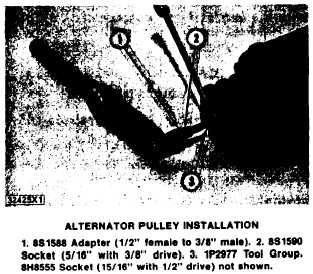ELECTRICAL SYSTEM
Delco-Remy Alternator; Pulley Nut Tightening
Tighten nut holding the pulley to a torque of 75 ±
5 lb. ft. (100 ± 7 N•m) with the tools shown.
STARTING SYSTEM
Tools Needed: 5P300 Electrical Tester
NOTE: Make reference to the instructions inside the
cover of the tester, when testing with the 5P300
Electrical Tester.
Use a D.C. Voltmeter to find the starting system
components which do not function.
Put the DISCONNECT SWITCH in the ON
position.
Move the starting control switch to activate the
starter solenoid. Starter solenoid operation can be
heard as the pinion of the starter motor is engaged
with the ring gear on the engine flywheel.
If the solenoid for the starter motor will not oper-
ate, it is possible that the current from the battery is
not getting to the solenoid. Fasten one lead of the
voltmeter to the connection (terminal) for the bat-
tery cable on the solenoid. Put the other lead to a
good ground. No voltmeter reading shows there is a
broken circuit from the
necessary when there is a
TESTING AND ADJUSTING
TM 5-3805-263-14&P-2
battery. More testing is
reading on the voltmeter.
The solenoid operation also closes the electric cir-
cuit to the motor. Connect one lead of the voltmeter
to the solenoid connection (terminal) that is fastened
to the motor. Put the other lead to a good ground.
Activate the starter solenoid and look at the volt-
meter. A reading of battery voltage shows the prob-
lem is in the motor. The motor must be removed for
further testing. No reading on the voltmeter shows
that the solenoid contacts do not close. This is an
indication of the need for repair to the solenoid or an
adjustment to be made to the starter pinion
clearance.
Make a test by fastening one voltmeter lead to the
connection (terminal) for the small wire at the solen-
oid and the other lead to the ground. Look at the
voltmeter and activate the starter solenoid. A volt-
meter reading shows that the problem is in the solen-
oid. No voltmeter reading shows that the problem is
in the heat-start switch or wiring.
Fasten one voltmeter lead to the heat-start switch
at the connection (terminal) for the wire from the
battery. Fasten the other lead to a good ground. No
voltmeter reading indicates a broken circuit from the
battery. Make a check of the circuit breaker and
wiring. If there is voltmeter reading, the malfunction
is in the heat-start switch or in the wiring.
Fasten one lead of the voltmeter to the battery wire
connection of the starter switch and put the other
lead to a good ground. A voltmeter reading indicates
a failure in the switch.
A starter motor that operates too slow can have an
overload because of too much friction in the engine
being started. Slow operation of the starter motor
can also be caused by shorts, loose connections
and/or dirt in the motor.
Pinion Clearance Adjustment (Prestolite)
There are two adjustments on this type motor.
Armature end play and pinion position.
Armature End Play
Adjust to .005 to .030 in. (0.13 to 0.76 mm) by
adding or removing thrust washers on the commuta-
tor end of the armature shaft.
Pinion Position
This adjustment is accomplished in two steps.
1-77

